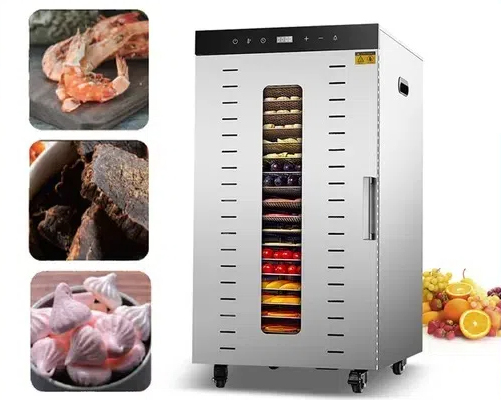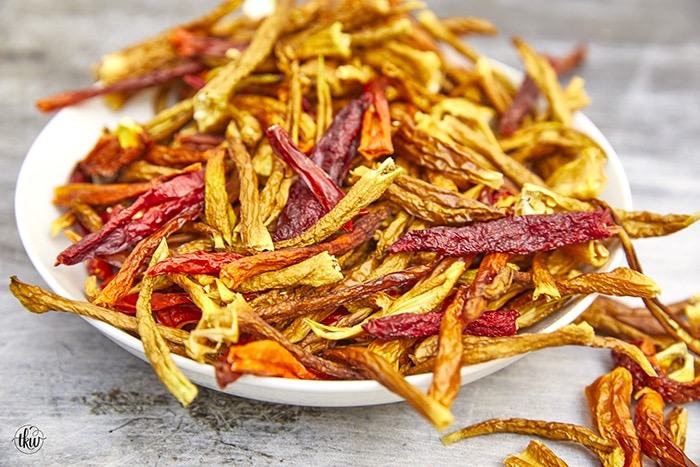
Content Menu
● The Importance of Drying in Food Processing
● Advantages of Hang Type Dryers
● Enhanced Air Circulation
● Preservation of Food Quality
● The Technology Behind Hang Type Dryers
● Key Features Include:
● Versatility in Food Processing
● Case Studies Demonstrating Success
● Best Practices for Implementing Hang Type Dryers
● Comparative Analysis with Other Drying Technologies
>> Tray Drying
>> Freeze-Drying
● Vacuum Drying
● Environmental Considerations
● Innovations in Hang Type Dryer Technology
● Economic Impacts on Manufacturers
● Cost Savings
● Increased Production Capacity
● Competitive Advantage
● Challenges Faced by Manufacturers
● Conclusion
● FAQ
>> 1. What types of foods can be dried using hang type dryers?
>> 2. How do hang type dryers improve energy efficiency?
>> 3. Can hang type dryers help with food safety?
>> 4. What are the advantages over traditional tray dryers?
>> 5. How does automation play a role in hang type dryers?
● Citations:
In the food processing industry, drying is a critical step that enhances food preservation, extends shelf life, and ensures safety. Among various drying technologies, hang type dryers have gained significant attention due to their unique advantages and operational efficiencies. This article delves into the features of hang type dryer technology, exploring its benefits, applications, and why manufacturers should consider integrating it into their production lines.

The Importance of Drying in Food Processing
Drying is essential in food processing as it involves removing moisture from food products. This process inhibits microbial growth and enzymatic activity that can spoil food. Effective drying methods help maintain the nutritional value of food items while ensuring safety and extending shelf life.
Key benefits of drying include:
1. Prevention of Spoilage: Reducing moisture content prevents the growth of yeast, bacteria, and fungi.
2. Extended Shelf Life: Properly dried foods can be stored for longer periods without refrigeration.
3. Preservation of Nutritional Value: Controlled drying processes help retain essential nutrients.
Advantages of Hang Type Dryers
Hang type dryers are specialized equipment designed to dry food products by suspending them from hangers within a controlled environment. This method is particularly effective for items like noodles, meats, fish, herbs, spices, fruits, and vegetables.
Enhanced Air Circulation
One of the standout features of hang type dryers is their design that promotes superior air circulation around food items. This leads to:
1. Faster Drying Times: Improved air circulation accelerates the drying process.
2. Uniform Moisture Removal: Consistent airflow prevents localized over-drying or under-drying.
Preservation of Food Quality
Hang type dryers help maintain the quality of food products through:
1. Retention of Volatile Compounds: Gentle drying minimizes the loss of essential oils and aromatic compounds.
2. Color and Texture Maintenance: Even drying preserves the natural color and texture of food products.
3. Prevention of Case Hardening: Uniform moisture removal reduces the risk of hardening on the outer layer.
The Technology Behind Hang Type Dryers
Modern hang type dryers often incorporate advanced technologies such as heat pump systems that can save up to 75% energy compared to traditional methods. This results in lower operational costs and reduced environmental impact.
Key Features Include:
1. Controlled Environment: Temperature, humidity, and airflow are precisely managed to optimize the drying process.
2. Reduced Contact Points: Minimizing contact with surfaces reduces the risk of sticking or deformation.
Versatility in Food Processing
Hang type dryers are suitable for a wide range of food products:
1. Noodles: Prevent clumping while ensuring uniform drying.
2. Meats: Provide controlled environments for curing and drying.
3. Fish and Seafood: Retain natural flavors and aromas.
4. Herbs and Spices: Preserve essential oils during low-temperature drying.
5. Fruits and Vegetables: Produce high-quality dried fruits with minimal nutrient loss.

Case Studies Demonstrating Success
Several manufacturers have successfully transitioned to hang type dryers with remarkable results:
1. ABC Noodles: A large noodle manufacturer replaced traditional tray dryers with hang type machines, resulting in a 20% reduction in waste and a 15% increase in production efficiency due to improved product quality.
2. XYZ Meats: A sausage producer implemented hang type dryers for curing processes, achieving a 30% reduction in curing time while maintaining desired flavor profiles.
3. Fresh Herbs Co.: A company specializing in dried herbs switched to hang type dryers and noted a significant improvement in color retention and aroma preservation, leading to increased customer satisfaction and repeat orders.
Best Practices for Implementing Hang Type Dryers
To maximize the benefits of hang type dryers, manufacturers should consider these best practices:
1. Ensure proper training for operators on the equipment's functionality.
2. Regularly maintain equipment to prevent breakdowns.
3. Monitor environmental conditions closely to optimize drying parameters.
4. Utilize automation features where available to enhance operational efficiency.
5. Incorporate energy recovery systems to further improve energy efficiency.
Comparative Analysis with Other Drying Technologies
To understand the true value of hang type dryer technology, it's essential to compare it with other common drying methods such as tray drying, freeze-drying, and vacuum drying.
Tray Drying
Tray drying is one of the most traditional methods used in food processing. While it is relatively simple and cost-effective, it has several limitations:
1. Inconsistent Drying: Airflow can be uneven across trays leading to inconsistent moisture levels.
2. Longer Drying Times: Compared to hang type dryers, tray dryers often require more time due to limited airflow around each piece.
Freeze-Drying
Freeze-drying is an advanced technique that removes moisture by freezing the product first and then sublimating ice directly into vapor. While this method preserves flavor and nutrients exceptionally well, it comes with high costs:
1. High Energy Consumption: Freeze-drying requires significant energy input making it less economical for large-scale operations.
2. Complex Equipment Needs: The machinery involved is often complex requiring specialized knowledge for operation.
Vacuum Drying
Vacuum drying operates under reduced pressure which lowers boiling points allowing moisture to evaporate at lower temperatures. However:
1. High Initial Investment: The setup costs for vacuum systems can be substantial.
2. Limited Product Types: Not all foods are suitable for vacuum drying due to texture changes or flavor loss during processing.
Environmental Considerations
As sustainability becomes increasingly important in manufacturing processes, hang type dryers stand out due to their energy efficiency. By utilizing heat pump technology:
1. Reduced Carbon Footprint: Energy-efficient operations contribute positively towards reducing overall greenhouse gas emissions.
2. Lower Water Usage: Compared to other methods that may require additional water for cooling or steaming processes, hang type dryers operate efficiently without excess water consumption.
Innovations in Hang Type Dryer Technology
The evolution of hang type dryer technology continues with innovations aimed at improving efficiency further:
1. IoT Integration: Smart sensors can monitor humidity levels and adjust airflow automatically ensuring optimal conditions throughout the drying cycle.
2. Modular Designs: New designs allow manufacturers to scale their operations easily by adding additional units as demand increases without significant infrastructure changes.
3. Energy Recovery Systems: These systems capture heat generated during operation and recycle it back into the process reducing overall energy consumption even further.
Economic Impacts on Manufacturers
Adopting hang type dryer technology can have profound economic implications for manufacturers:
Cost Savings
The initial investment in hang type dryer systems may be higher than traditional methods; however, the long-term savings can be substantial due to reduced energy costs and increased production efficiency.
For example:
1. A manufacturer using traditional methods may incur higher utility bills due to inefficient energy use.
2. With heat pump technology integrated into hang type dryers, companies can expect a significant reduction in monthly energy expenses—often recouping their investment within a few years through these savings alone.
Increased Production Capacity
With faster drying times and improved quality control:
1. Manufacturers can increase their output without compromising on quality.
2. This allows businesses not only to meet existing demand but also to explore new markets or product lines—potentially leading to increased revenue streams.
Competitive Advantage
As consumers become more health-conscious:
1. The demand for high-quality dried foods continues to rise.
2. Manufacturers who adopt advanced technologies like hang type dryers position themselves favorably against competitors still relying on outdated methods—enhancing their market share over time.
Challenges Faced by Manufacturers
Despite its numerous advantages, transitioning to hang type dryer technology does come with challenges:
1. Initial Capital Investment: The upfront costs associated with purchasing new equipment can be daunting for some businesses—especially smaller operations.
2. Training Requirements: Employees may need extensive training on new systems which could lead to temporary disruptions during implementation phases.
3. Maintenance Needs: While generally reliable, advanced machinery requires regular maintenance checks which could add another layer of operational complexity.
Conclusion
Hang type dryer technology represents a significant advancement in food processing methods. Its ability to provide controlled environments for drying while maintaining food quality makes it an attractive option for manufacturers looking to enhance their production processes. With its energy efficiency and versatility across various food products, integrating hang type dryers can lead to substantial improvements in operational efficiency and product quality.
As manufacturers continue seeking ways to improve productivity while adhering to sustainability goals, hang type dryer technology stands out as a promising solution that meets both economic and environmental needs effectively.

FAQ
1. What types of foods can be dried using hang type dryers?
Hang type dryers are suitable for various foods including noodles, meats, fish, herbs, spices, fruits, and vegetables.
2. How do hang type dryers improve energy efficiency?
They often incorporate heat pump technology which can save up to 75% energy compared to traditional drying methods.
3. Can hang type dryers help with food safety?
Yes, by providing controlled environments that prevent bacterial growth during the drying process.
4. What are the advantages over traditional tray dryers?
Hang type dryers offer better airflow management leading to more uniform drying with less risk of product sticking or deformation compared to tray dryers.
5. How does automation play a role in hang type dryers?
Modern hang type dryers can include automation features such as automatic loading/unloading systems which enhance operational efficiency.
Citations:
[1] https://www.dryeratech.com/why-every-manufacturer-should-consider-a-hang-type-dryer.html
[2] https://www.bchydro.com/news/conservation/2019/hang-dry-your-clothes.html
[3] https://patents.google.com/patent/CN110207480A/zh
[4] https://www.dryeratech.com/innovations-in-hang-type-dryer-technology-you-should-know-about.html
[5] https://www.dryeratech.com/hang-type-vs-rack-dryers-pros-and-cons.html
[6] https://patents.google.com/patent/WO2022068971A1/zh
[7] https://gcwgandhinagar.com/econtent/document/1588156026Unit%20V%20Types%20of%20dryers%20and%20their%20applications.pdf
[8] https://www.bchydro.com/powersmart/residential/tips-technologies/hang-dry-laundry.html











